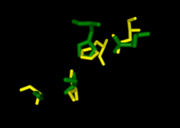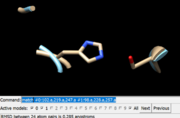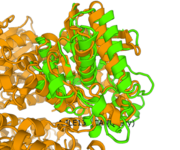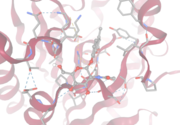Sandbox2QRU
From Proteopedia
(Difference between revisions)
| (6 intermediate revisions not shown.) | |||
| Line 7: | Line 7: | ||
2QRU is known to be a hydrolase, most active on esterase. The structure is 276 amino acids long, which is approximately 30.14 kDa. Knowing 2QRU is an alpha/beta hydrolase, the literature helped give further information on possible experimental conditions and substrates that can be used to identify activity. However, experimental data has not been obtained yet. | 2QRU is known to be a hydrolase, most active on esterase. The structure is 276 amino acids long, which is approximately 30.14 kDa. Knowing 2QRU is an alpha/beta hydrolase, the literature helped give further information on possible experimental conditions and substrates that can be used to identify activity. However, experimental data has not been obtained yet. | ||
| + | |||
== Structure/Sequence Analysis == | == Structure/Sequence Analysis == | ||
'''Sequence Analysis''' | '''Sequence Analysis''' | ||
| + | |||
'''SPRITE''' | '''SPRITE''' | ||
| - | + | [[Image:2QRU(green)2LPR(yellow).png | thumb]]Analysis with Sprite displayed the proteins closest in structure to 2QRU. To do this, Sprite analyzed 2QRU for an active site with a motif of known catalytic function and compares to proteins known in the database. Among the proteins with the highest alignment (lowest RMSD) with a RMSD of 1.17 is 2LPR, a hydrolase. The amino acids included in the active site was 102 Ser, 104 Gly, 219 Asp, 247 His. | |
'''Chimera''' | '''Chimera''' | ||
| Line 19: | Line 21: | ||
'''BLAST''' | '''BLAST''' | ||
| + | |||
Blast is a sequence searching tool that allows for analysis of 2QRU’s protein sequence and therefore further predictions for the protein. The results display a list of proteins that are the closest in sequence to the one entered arranged by Query Coverage (higher value favored out of 100%), and E Value (lower value favored). Among the top Blast results for 2QRU many similarly structured proteins were listed under the family of alpha/beta hydrolases. | Blast is a sequence searching tool that allows for analysis of 2QRU’s protein sequence and therefore further predictions for the protein. The results display a list of proteins that are the closest in sequence to the one entered arranged by Query Coverage (higher value favored out of 100%), and E Value (lower value favored). Among the top Blast results for 2QRU many similarly structured proteins were listed under the family of alpha/beta hydrolases. | ||
| Line 27: | Line 30: | ||
'''InterPRO''' | '''InterPRO''' | ||
| + | |||
Investigation with InterPro showed the likely family of this enzyme was an alpha/beta hydrolase. Specifically, 2QRU was classified as a GDXG lipolytic enzyme. This family is generally associated with the hydrolysis of short fatty esters up to 8 carbons in length. Enzymes within this family are known to be involved in plant wall degradation and tryptophan synthesis. | Investigation with InterPro showed the likely family of this enzyme was an alpha/beta hydrolase. Specifically, 2QRU was classified as a GDXG lipolytic enzyme. This family is generally associated with the hydrolysis of short fatty esters up to 8 carbons in length. Enzymes within this family are known to be involved in plant wall degradation and tryptophan synthesis. | ||
| + | |||
'''SwissDock''' | '''SwissDock''' | ||
| Line 37: | Line 42: | ||
Based on the sequence and structural analysis via computational modeling, it is known that the primary function of 2QRU is an alpha/beta hydrolase. Using the Swiss dock, we know the substrates with the highest bonding affinity were sugar-like molecules. This produces bond affinities of -6 or lower. Knowing this, it is hypothesized that 2QRU would be used in biological systems that need to break down sugars for energy, like fermentation or cellular respiration. Where exactly this would occur or on which sugar is unknown at this time, but experimental results may aid in finding what substrate works the best and in what environment. | Based on the sequence and structural analysis via computational modeling, it is known that the primary function of 2QRU is an alpha/beta hydrolase. Using the Swiss dock, we know the substrates with the highest bonding affinity were sugar-like molecules. This produces bond affinities of -6 or lower. Knowing this, it is hypothesized that 2QRU would be used in biological systems that need to break down sugars for energy, like fermentation or cellular respiration. Where exactly this would occur or on which sugar is unknown at this time, but experimental results may aid in finding what substrate works the best and in what environment. | ||
| - | |||
| - | == Relevance == | ||
Current revision
Overview
| |||||||||||





